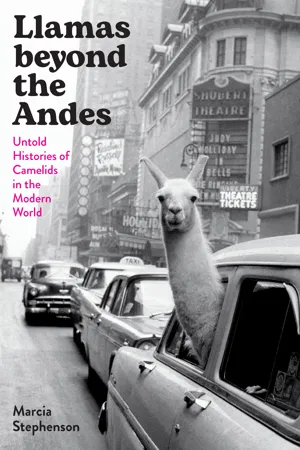
Llamas beyond the Andes
Untold Histories of Camelids in the Modern World
- 448 pages
- English
- ePUB (mobile friendly)
- Available on iOS & Android
About This Book
Camelids are vital to the cultures and economies of the Andes. The animals have also been at the heart of ecological and social catastrophe: Europeans overhunted wild vicuña and guanaco and imposed husbandry and breeding practices that decimated llama and alpaca flocks that had been successfully tended by Indigenous peoples for generations. Yet the colonial encounter with these animals was not limited to the New World. Llamas beyond the Andes tells the five-hundred-year history of animals removed from their native habitats and transported overseas.
Initially Europeans prized camelids for the bezoar stones found in their guts: boluses of ingested matter that were thought to have curative powers. Then the animals themselves were shipped abroad as exotica. As Europeans and US Americans came to recognize the economic value of camelids, new questions emerged: What would these novel sources of protein and fiber mean for the sheep industry? And how best to cultivate herds? Andeans had the expertise, but knowledge sharing was rarely easy. Marcia Stephenson explores the myriad scientific, commercial, and cultural interests that have attended camelids globally, making these animals a critical meeting point for diverse groups from the North and South.
Frequently asked questions
Information
Table of contents
- Cover
- Series Page
- Title Page
- Copyright
- Contents
- List of Abbreviations
- Introduction. “The Most Interesting Animals in the World”: Reconstructing Histories of Andean Camelids in Transoceanic Contact Zones
- Chapter 1. From Marvelous Antidote to the Poison of Idolatry: The Transatlantic Significance of Andean Bezoar Stones during the Late Sixteenth and Early Seventeenth Centuries
- Chapter 2. Exploring the Body-Interior: Autopsy in Colonial Camelid Contact Zones
- Chapter 3. From Curiosity to Commodity: Early Efforts to Ship Living Camelids to Europe
- Chapter 4. The Science of Acclimatization: Llamas and Alpacas in Nineteenth-Century France
- Chapter 5. Andean Itineraries of Nineteenth-Century Camelid Science: The Case of Charles Ledger
- Chapter 6. Camelids in Australia: The Rise and Fall of Charles Ledger’s Alpaca Ambitions
- Chapter 7. US Camelid Contact Zones in the Twentieth Century: Authenticity, Exoticism, and Celebrity
- Conclusion. The Afterlives of Camelid Contact Zones
- Acknowledgments
- Notes
- Works Cited
- Index